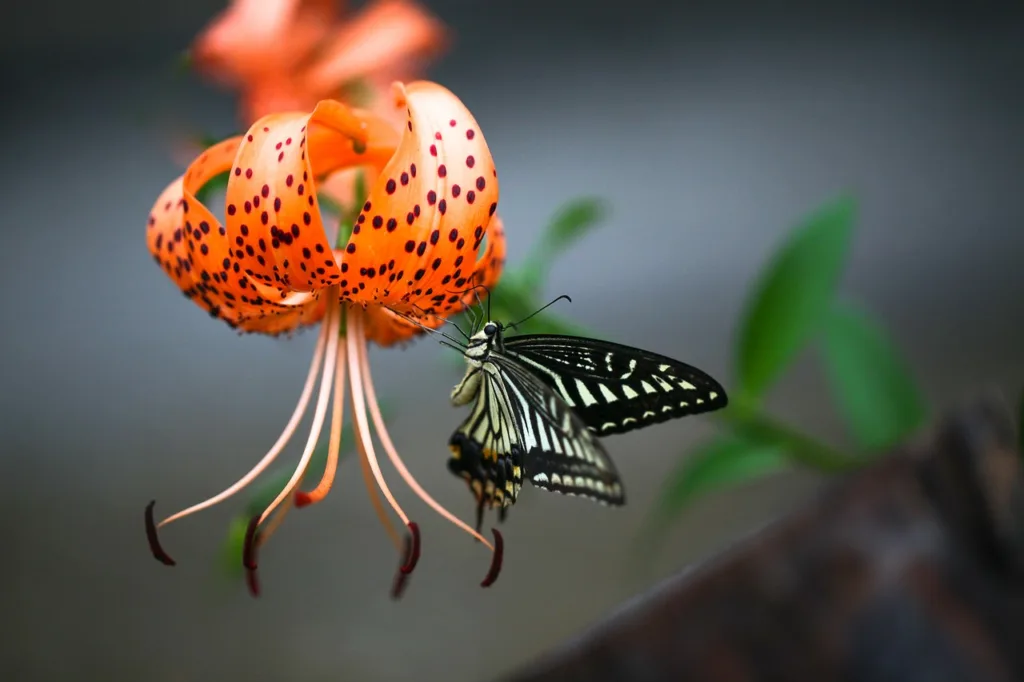Are you a fan of vibrant, exotic flowers that can instantly brighten up your garden or home? Look no further than the stunning tiger lilies. With their bold colors and unique patterns, tiger lilies are a true showstopper.
Whether you’re new to gardening or an experienced green thumb, this comprehensive guide will teach you everything you need to know about growing and caring for tiger lilies.
What is Tiger Lilies
Tiger lilies, scientifically known as Lilium lancifolium or Lilium tigrinum, are native to East Asia but have become a popular choice among gardeners worldwide due to their striking appearance and easy cultivation.
These perennial flowers, known for their tall stems adorned with large, trumpet-shaped blooms, are a beautiful addition to any garden or floral arrangement.
In this blog post, we’ll explore the various aspects of cultivating tiger lilies, including planting, soil requirements, watering, fertilizing, and common diseases or pests to watch out for.
As we dive deep into each topic, you’ll discover useful tips and tricks to ensure your tiger lilies thrive and dazzle with their brilliant colors.
Care and Grow a Tiger Lilies
When it comes to planting tiger lily seeds, timing is crucial. These bulbs should be planted in the fall, ideally during the months of September to October, before the frost sets in.
Choose a location that receives ample sunlight, as tiger lilies require at least six hours of direct sunlight per day.
Before planting, prepare the soil by removing any weeds or debris and loosening it with a garden fork or tiller. Tiger lilies prefer well-drained, well-drained soil rich in organic matter such as compost or well-rotted manure.
The pH level should be slightly acidic to neutral, around 5.5 to 7.0. If your soil is too alkaline, consider adding sulfur to lower the pH.
Dig a hole that is approximately six to eight inches deep, and space each bulb about eight to twelve inches apart. Place the bulb in the hole, with the pointed end facing up, and cover it with soil.
Lightly press down the soil to eliminate air pockets. Water the newly planted bulbs thoroughly.
| Aspect | Description |
|---|---|
| Common Name | Tiger Lily |
| Scientific Name | Lilium lancifolium |
| Flower Appearance | Fiery orange with dark spots |
| Plant Type | Hardy perennial |
| Ideal Environment | Well-drained soil, partial to full sun |
| Bloom Season | Typically mid to late summer |
| Landscaping Use | Ornamental gardens, cut flowers |
| Maintenance | Low-maintenance, easy to cultivate |

Soil Requirements
As mentioned earlier, tiger lilies thrive in well-drained soil. If your garden has heavy clay soil, consider adding organic matter such as compost to improve its drainage capacity. This will prevent waterlogging of the soil, which can cause root rot and other diseases.
Additionally, tiger lilies prefer slightly acidic soil over neutral soil. Acidic soils can be improved by adding lime, while alkaline soils may require sulfur or acidic products. Testing your soil’s pH level can help you accurately assess its needs.
Watering Tiger Lilies
Proper watering is essential for the healthy growth of tiger lilies. As a general rule of thumb, these plants require regular watering, especially during the summer months when rainfall may be insufficient. However, it’s crucial not to overwater, as excessive moisture can cause bulb or root rot.
Water your tiger lilies deeply once a week, ensuring the soil receives at least one inch of water. To prevent waterlogging, check the soil’s moisture level before watering. If the top one to two inches are dry, it’s time to water the plants. Using a soaker hose or a drip irrigation system is ideal, as it delivers water directly to the root zone, minimizing moisture on the leaves and flowers.
During the winter months, when tiger lilies are dormant, reduce watering frequency. Too much moisture during this period can lead to fungal diseases and bulb deterioration. Instead, rely on natural rainfall and only water if the weather has been exceptionally dry.
Fertilizing Tiger Lilies
To promote robust growth and abundant blooms, tiger lilies benefit from regular fertilization. Before planting the bulbs, mix a balanced, slow-release fertilizer into the soil to provide a good foundation of nutrients. This will sustain the plants throughout their growth cycle.
After the initial fertilizer application, continue feeding your tiger lilies in early spring before new growth appears. Use a high-phosphorus fertilizer, such as a 5-10-10 or 10-20-20 blend, which encourages blooming and root development. Avoid excessive nitrogen, as it can lead to tall, weak stems and fewer blooms.
Apply the fertilizer according to the package instructions, usually one tablespoon per square foot of the planting area. Spread it evenly around the plants, being careful to avoid direct contact with the stems or leaves. Water the area thoroughly after fertilization to help the nutrients reach the root zone.
Types of Tiger Lilies
Tiger lilies belong to the genus Lilium and are known for their elegant beauty and vibrant appearance. The various types of Tiger lilies include:
- Lilium lancifolium (Lilium tigrinum): This is the common variety often referred to as Tiger Lily. It features orange flowers covered with dark spots.
- Splendens: This type features bright orange flowers with black spots.
- Album: This is a white variety with yellow spots, distinct from the typical orange Tiger Lily.
- Flore Pleno: Also known as the Double Tiger Lily, it exhibits double-petaled, more lush, and fuller flowers.
- Tiger Lily Hybrids: Many hybrid versions have been developed, featuring varied colors and patterns, derived from crossing different species or hybrids.
How to make a tiger lily bloom?
In the shine of the sun, tiger lilies emerge, their bulbs nestled 4 inches deep in well-drained soil. It’s important to keep their thirst in check – not too much, not too little. With a touch of balanced fertilizer in the spring and early summer, these beauties flourish.
To encourage vibrant flowering, faded flowers are gently removed. As the weather changes, their leaves fade beautifully, protecting the lilies for the winter. Following these steps portrays the journey of the Tiger Lily to a bright and vibrant blooming form.
Common Diseases and Pests
While tiger lilies are relatively hardy plants, they can still fall victim to certain diseases and pests. Being aware of these common issues will help you take prompt action and prevent significant damage.
One of the most common diseases affecting tiger lilies is botrytis blight, also known as gray mold. This fungal infection causes gray or brown spots on the leaves and stems, eventually leading to wilting and decay.
To prevent botrytis blight, ensure the plants have proper air circulation by spacing them adequately. Remove any infected plant parts and dispose of them in sealed bags, away from other plants.
Aphids are another frequent problem for tiger lilies. These small, soft-bodied insects suck sap from the leaves, resulting in curled or distorted growth.
To control aphids, spray the affected plants with a strong stream of water to dislodge them or apply an insecticidal soap. Ladybugs and lacewings are natural predators that feed on aphids and can help control their population.
Tiger lilies offer both aesthetic and environmental benefits
- Ornamental Beauty: These lilies are valued for their stunning, showy blooms, adding vibrant colors to gardens, landscapes, and floral arrangements.
- Attracts Pollinators: The brightly colored, large, and fragrant flowers attract pollinators like bees, butterflies, and hummingbirds, aiding in garden pollination.
- Low Maintenance: Tiger lilies are relatively easy to grow and maintain, making them suitable for beginner gardeners. They thrive in various soil types and are hardy against pests and diseases.
- Naturalization: These flowers can naturalize over time, forming dense clumps, and spreading beauty across the garden.
- Longevity: When cultivated in the right conditions, Tiger Lilies can thrive for many years, providing recurring floral displays annually.

Conclusion
Congratulations! You’ve successfully learned how to grow and care for tiger lilies, ensuring they flourish and provide a stunning display of colors in your garden.
Remember to plant the bulbs in the fall, provide well-draining, slightly acidic soil, and water them appropriately throughout the growing season. Fertilize the plants to encourage healthy growth and be vigilant against common diseases and pests.
By following the tips and techniques outlined in this guide, you’ll be well on your way to creating a mesmerizing oasis of tiger lilies. So go ahead and the beauty and elegance of these remarkable flowers, and let them bring joy and enchantment to your outdoor spaces. Happy gardening!
People Also Ask
What is special about the tiger lily?
Tiger lilies are prized for their vivid look and remarkable beauty. Their enormous, beautiful blossoms are particularly unique and visually appealing in gardens and floral arrangements because of their striking orange color, which occasionally has dark patches.
Is a tiger lily poisonous?
It is true that cats get poisoned by tiger lilies (Lilium lancifolium and related plants). These lilies can be lethal to cats and cause serious health problems if consumed. It is imperative that you seek immediate veterinarian attention if you fear your cat has eaten any part of a tiger lily.
What do Tiger Lilies Symbolise?
Many symbolic meanings, including pride, riches, optimism, confidence, and bravery, are connected to tigers. They may also stand for rebirth, intense feelings, and desire. Tiger lilies are also associated with feminine bravery, fertility, and maternal softness.
Where do tiger lilies grow?
These vibrant flowers are often seen in gardens, parks, and natural landscapes across North America, Europe, and Asia.

